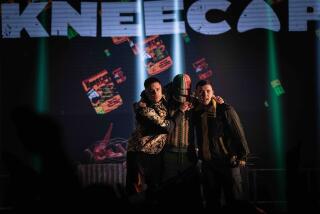All Together IN AN Irish Cottage
TOURMAKEADY, Ireland — My parents chose Knights Cottage in Tourmakeady for a few good reasons. It is in Mayo, which, after years of travel in Ireland, they consider the loveliest of the counties; it came highly recommended; has a red door and a thatched roof; is nestled in the velvety Partry Mountains overlooking Lough Mask; and is close enough to the city of Galway (40 miles) to be considered semi-urban.
But mostly they chose it because it has three bedrooms and three bathrooms. When planning a multi-generational group vacation, you can’t have too many bathrooms.
The McNamara clan has learned this the hard way. Three previous trips to charming-but-one-bathroom rentals in Ireland made clear an essential tenet of family travel: Avoid any potential source of tension you can think of; there will be enough unexpected ones to go around.
And this trip last summer was the most ambitious of all, including, for various lengths of time, 10 of us: my parents, Jim and Jinx, coming from New Mexico; my brother, Jay, and his companion, Steven; me, my husband, Richard, and our then 14-month-old son, Danny Mac, all from Los Angeles; our friend Susan, also from L.A.; and, for a few days only, our cousin, Mary, and her husband, Joel, from Chicago.
That’s a pretty big group, especially considering it contains more than a few people who don’t like groups. Fortunately, we were of one mind--optimistic--about our destination: the West Country of Ireland. In June. When the yellow gorse that borders every field blooms and blows the air sweet, when the lacy apple blossoms turn country roads into floral tunnels, when the sun coaxes foxglove and wild iris and buttercups and bluebells from the emerald grass.
May, June and July are the fairest months for travel in Ireland, although even then there will be rain and clouds to darken the greens and golds. On those days, the hills and cliffs cut darkly against the sky and the wind wrinkles the skin of lake and river. Wet or dry, chilly or sunny, Ireland is one of the most beautiful places on Earth.
And for travelers with a range of ages, interests, mobility and attention span, Ireland may be the perfect vacation spot. Everyone speaks English, the food is familiar and touring can be as simple as strolling down a country lane. For children there are lots of nifty ruins and walled fields to climb and explore, and for grown-ups there is much beauty and peace, free of the rush to beat the crowds to the museums or box office. Yes, the cities, especially Dublin and Galway, are bursting with theaters and restaurants, shops and pubs, but they are still small cities, manageable on foot, with plenty of public benches and places of respite for the less energetic among us.
Renting a house is practical, especially for the eldest and youngest family members. You don’t have to eat out at every meal, and you have access to a washer and dryer. (Irish washing machines are slow by U.S. standards, but our whites will never be whiter.) There’s also much more privacy and room to spread out than in most hotels, and you have the feeling of belonging, of being part of the landscape, that you don’t get even in the most comfortable B&B.;
And, especially if your party is a large one, it is easily the least expensive way to travel.
After almost 10 years of Ireland summers, my parents are veteran renters. With the help of a travel agency in New Jersey, they booked the Tourmakeady cottage for six weeks, paying about $3,000 (slightly lower than the normal rate because of the length of their stay). Arriving first, they informed us in the echoing stutter of international phone communication that the place was absolutely beautiful, the Staunton family who owned it was warm and friendly, the weather was fair and fine, and there was a crib but no highchair.
This is another thing we have learned about family traveling: It is always better if one subset agrees to get there first. Two people settling in, finding out where the grocery store is, how the heat works, where the sheets are, is a lot less chaotic than six people arguing over the biggest bedroom.
For those of us with somewhat controlling natures, travel with a group poses a challenge: Sooner or later you learn that all your helpful suggestions about airlines and airports and what to pack and how much money to change and where we should all meet up and remembering to bring Equal because the tea shops don’t often have it are falling not only on deaf ears, but also on increasingly annoyed ears. Fortunately, this time around I was traveling with my toddler, which kept my obsessiveness fully occupied, from procuring his passport to debating whether to bring diapers or buy them there. (I brought, a coals-to-Newcastle move for which I was roundly ridiculed.)
Knights Cottage was just as lovely as my parents had described. Overlooking Lough Mask (a lough is a lake), where a fleet of swans made a daily appearance and wild iris fringed the rocky shore, it was part of a small community of flower-box-bedecked houses, charming bed-and-breakfasts, sheep ranches and farms. Just next door live the proprietors, Tom and Maura Staunton, and their five children, a rosy-cheeked, friendly family to which Danny Mac instantly attached himself. Their house also includes bed-and-breakfast rooms, which worked out well for our extended family: When Jay and Steven arrived, Susan exchanged her double for a room next door.
The Stauntons also run a working sheep ranch, a dozen or so members of which capered in the fenced front field; later in the visit we watched in awe as Tom and several of the older children sheared 10 or so sheep by hand. So without even stirring much beyond our doorstep, there were baby lambs to feed, a puppy to play with and cows to talk to. The endless summer light--the sun didn’t really set until after 10 and was up by 4--made it impossible to stay inside for long, especially when there is a small person in brand-new boots pressed against the window, pointing at all the white fleecy “dogs.”
While Tourmakeady (pronounced TOOR-muh-keedy) is ignored by all the guidebooks I’ve seen, it proved to be an excellent home base. Nearby Westport is a bustling river town with shops and restaurants galore that stands in the shadow of Croagh Patrick, the mountain upon which St. Patrick prayed and fasted before trekking down to establish the first Christian church in Ireland.
Between Tourmakeady and Westport stands Ballintubber Abbey and its restored 13th century church. Here pilgrims begin the 14-mile walk up Croagh Patrick (elevation 2,510 feet), following the saint’s steps.
At Westport you can catch a ferry to Clare Island, on which stands the castle that was the stronghold of Grace O’Malley, the 16th century pirate queen. (Her son Theobald of the Long Ships is buried in the abbey church.)
One of the roads connecting Westport and nearby Leenane runs through the gorgeous Doo Valley. During the potato famine of the 1840s, about 600 hungry souls walked through the valley in hope of finding relief at a landowner’s manor house, Delphi Lodge. It was denied them, and more than 400 perished. A memorial to them stands along the road.
Around Tourmakeady in every direction are various ruined round towers, churches and one delightfully eerie mansion, Moore House, which belonged to one of the few landowners who actually helped the local poor during the famine. Ten or so miles away is the town of Cong, around which parts of “The Quiet Man” were filmed. The town itself is small, with the obligatory ruined abbey, but the countryside is gorgeous, full of jagged fells and glinting lakes, stone-walled fields and more sheep than you can shake a shillelaghat.
We went for several walks in the area between Tourmakeady and Cong, and along the way we learned a bit about the Irish character. Time and distance do not have quite the same meaning here. For one thing, the Irish certainly walk faster than most mere mortals, so if the nice woman who runs your bed-and-breakfast says the little jaunt she’s marked out for you, the one she takes every Sunday after Mass, will take you “oh, only an hour or so,” figure at least two, possibly three.
Beyond the charms of its immediate environs, Tourmakeady is well situated for day trips. Galway, the fastest-growing city in Europe (as we were reminded repeatedly by locals), is less than an hour away, as is Rossaveal,the landing for the ferry to the Aran Islands. (There is also a ferry from Galway, but the trip takes almost two hours, twice as long as that from Rossaveal.)
(A word or two about driving in Ireland: Yes, it is done on the “wrong” side of the road and from the “wrong” side of the car. This last is further complicated by the fact that standard transmission cars are the norm and much cheaper to rent, which means learning how to shift with your left hand, a task that at first seems insurmountable but actually becomes quite second-nature.)
We visited Inishmore, the largest and most commercial of the Arans--meaning there are a handful of B&Bs;, a few pubs and three sweater shops--on a spectacularly bright, fine day with about 500 Irish teenagers, giddy with freedom and the end of exams. At the end of the day, we all piled onto the return ferry and watched the teens eat unmeasurable quantities of cheese-and-bacon crisps (potato chips) and chocolate bars as they laughed and flirted and compared sunburns--the sun was such that Danny Mac became the first child ever to travel from Los Angeles to Ireland to get his first tan.
Up north, Sligo and Joyce country was another easy day trip, as was Downpatrick Head, a wild and windy place of cliffs and stormy solitude, and the Ceide Fields, an archeological site that I found fascinating and everyone else in our party thought was a bore.
Another day saw us driving south to Connemara, a gorgeous county on the Atlantic. A visit to Connemara’s KylemoreAbbey estate, a monument to Anglo-Irish wealth in the 1860s, will reacquaint you with the tour-bus crowd (and the midge population, so bring bug repellent). Connemara National Park has many glorious hiking trails, including several easy but well-marked scenic walks. Farther south, we made a day’s journey to the Cliffs of Moher and the Burren, two not-to-be-missed miracles of nature just below Galway.
We did not, as a rule, travel en masse. Our days started when everyone met for breakfast at the cottage and made their way through the enormous pot of Irish oatmeal my father insisted on preparing each and every day (accompanied, thankfully, by much toast, brown bread and scones).
Then each pairing or group would set off on whatever adventure they sought. But for anyone with a drop of Irish blood, time in Ireland is as much about returning as it is about travel--and for our family, separated at home by thousands of miles, the evenings were as important as the days.
On several nights we visited the local restaurants and pubs all together, for the music and the extraordinary camaraderie found only in towns where everyone literally knows everyone, including you--”Ah, the Yanks,” the locals would say in greeting. But mostly we stuck to our lovely cottage, gathering around the peat fire to eat cream cakes and be a family again if only for a short while.
We watched the local news, which while more sedate than in L.A. somehow sounds more significant; maybe it’s the accent. My father was relieved to discover that “Ally McBeal” has a Celtic following, strange as it is to watch American TV in a thatched cottage. Steven got to catch up on the British drama “Coronation Street.” And I was happy to find that “Ballykissangel,” a series I’d enjoyed the last time I was in Ireland, eight years ago, was still on.
The nocturnal sunshine made it impossible to turn in before 11, and so there were 10 p.m. rambles around the lake and much drowsy armchair talking. My parents were able to spend time with the grandson they see so seldom; for his nana, Danny Mac would miraculously sit through the reading of any book, and he nodded off every night in his grandpa’s lap.
It was as close to idyllic as our family has gotten, in my memory anyway. There were no cross words or sulking or eye-rolling sarcasm, none of the reversion to adolescence that had been known to strike in the past. The presence of three cars and miles of roads to calm grated nerves helped. Or perhaps it was the light, or the lake, or the presence of a small child--our family was, for those two weeks, made up of loving and sensible adults, bent on sharing the beauty of new sights and memories in this fair and gentle land.
And that alone was worth the plane fare.
(BEGIN TEXT OF INFOBOX / INFOGRAPHIC)
GUIDEBOOK
Making Your Way to County Mayo
Getting there: Aer Lingus flies nonstop from LAX to Dublin, with connecting service to west Ireland’s Shannon airport, about a 2 1/2-hour drive from Tourmakeady. Continental Airlines offers direct (no plane change) flights to Shannon, and Delta has connecting service. Restricted round-trip air fares begin at $755 until May 31, then increase to $808.
Getting around: We rented a car from Dan Dooley Rent-a-Car, a large agency in Ireland, telephone (800) 331-9301, but most of the major companies have offices at or near Shannon airport. When making the reservation, I learned that many credit card companies no longer offer free insurance for cars rented in Ireland. And renting a car here isn’t particularly cheap--upward of $250 a week--nor is gas, at more than $2 a gallon. But unless you want to spend a good deal of your vacation figuring out the local train and bus schedules, it’s money well spent.
Where to stay: To book the Tourmakeady cottage, my parents used Patrician Journeys, an agency in New Jersey that specializes in Ireland; tel. (800) 344-1443, fax (973) 992-9804, Internet https://www.patricianjourneys.com. Knights Cottage rents for about $350 per week this year, but rises to about $438 a week during high season, July and August; tel./fax 011-353-92-44163, Internet https://www.tourmakeady.com/knightscottage.htm. Under the same ownership (and same telephone), Radharc na nOilean Bed and Breakfast next door costs about $20 per person per night, including full Irish breakfast. Mask View Bed and Breakfast, just down the road, has a beautiful garden and views of the lake beyond; tel. 011-353-92-44021, Internet https://www.tourmakeady.com/maskview.htm. But there are several otter B&Bs; along the lake. For a list of other Tourmakeady accommodations, visit https://www.tourmakeady.com.
Where to eat: We mostly took our meals at the cottage, but several nights we ate at Paddy’s Thatch Restaurant, local tel. 092-44243, in a building as picturesque as its name and with wonderful steak, fish and pasta dishes, in huge portions; entrees are $8 to $20. The most popular local pub is Maire Luke’s, tel. 092-44080, where we didn’t eat but listened to Irish music and watched the locals dance.
For more information: Irish Tourist Board, 345 Park Ave., 17th Floor, New York, NY 10154; tel. (800) 223-6470 or (212) 418-0800, fax (800) 749-3739, Internet https://www.irelandvacations.com.
Taking the Kids
* Tips to help in planning a family reunion, L13.
More to Read
Sign up for The Wild
We’ll help you find the best places to hike, bike and run, as well as the perfect silent spots for meditation and yoga.
You may occasionally receive promotional content from the Los Angeles Times.







